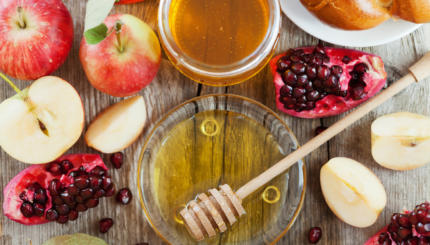, which celebrates the events described in the Scroll of Esther (Megillat Esther), is a day of rejoicing and merriment, on which even an unusually large amount of drinking is permitted. Jews act out their joy for having survived wicked Haman’s attempts to destroy them.
Purim comes at just the right time of year. While we are still suffering from the cold and grey of winter, Purim provides an opportunity for sunny, bright rejoicing. In Esther 9:19 it states, “Therefore do the Jews of the villages, that dwell in the unwalled towns, make the 14th day of the month of a day of gladness and feasting, and a good day, and of sending portions to one another.”
Traditionally observant Jews fast on the day before Purim (the 13th of Adar); it is called the Fast of Esther (Ta’anit Esther). It is one of the four public fasts of the Jewish calendar and commemorates Esther’s request to her uncle Mordecai to proclaim a three-day fast after learning about Haman’s plans to destroy the Jews. After the fast comes the time for celebration, feasting, and gladness.
A special festive meal, called Seudat Purim, is eaten on Purim afternoon. It is at this meal that the sages permitted an unusually great amount of levity and drinking. In the Talmud, Rava said, “A person should be so exhilarated (with drink) on Purim that he does not know between ‘cursed be Haman’ and ‘blessed be Mordecai.'” The words “that he does not know” (Hebrew: ad lo yada) comprise one of the themes of the Purim celebration. The drinking is also related to the fact that the victory over Haman began at a banquet of wine to which Esther invited Ahasuerus and Haman. (Ad lo yada is also the name of an elaborate parade with floats, bands, marchers, costumes and dancing in the streets and squares of Israel during Purim.)

Help us keep Jewish knowledge accessible to millions of people around the world.
Your donation to My Jewish Learning fuels endless journeys of Jewish discovery. With your help, My Jewish Learning can continue to provide nonstop opportunities for learning, connection and growth.
During the special festive meal it was customary for children — and many adults — to wear costumes, sing songs, and render humorous dramatic recitations. Nowadays, it is most common for children to dress up, play games, and perform Purim shpiels (humorous dramatic recitations) in religious schools.
Purim is a time when Jews are supposed to be especially generous. On this holiday, it is customary to give matanot l’evyonim (gifts to the needy) and mishloach manot (the sending of gifts of food, such as biscuits, almonds, wine, and grapes to each other). The custom of is also referred to in Yiddish as shalach mones. Many Jews prepare packages of food that they give to neighbors, friends, family, and colleagues on Purim.

The food associated with Purim are specially shaped cookies called Hamantashen. These cookies are three-cornered pastries filled most often with poppy seed, but also prune and other fruit fillings. The Yiddish name of these cookies means “Haman’s pockets.” In Hebrew, the name oznay Haman means “Haman’s ears.” The triangular shape may have been influenced by old illustrations of Haman, in which he wore a three-cornered hat. The baking of these Hamantaschen has become a favorite Purim family activity.
Purim, more than any of the other Jewish holidays, is a time of joyous revelry and release. It highlights the perennial problem of maintaining Jewish identity while living in the Diaspora. It focuses on the powerless and disenfranchised, who with prudence and courage, triumph over those who have worldly power and unlimited hatred. It is for this reason that Jews rejoice with feasting and gladness on this festival.




